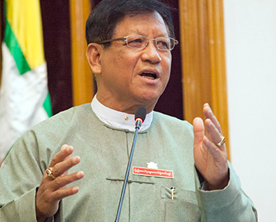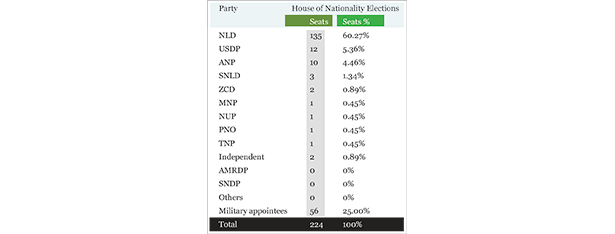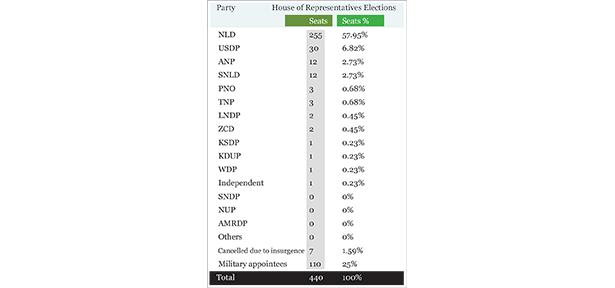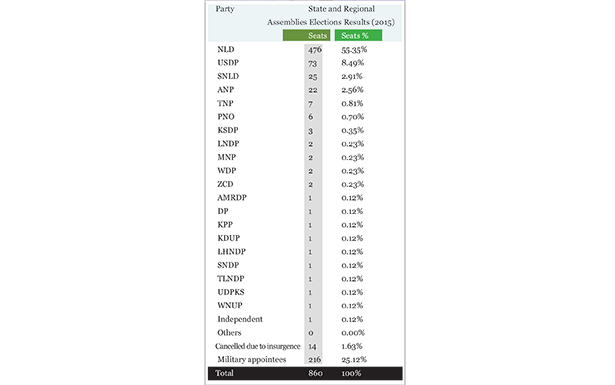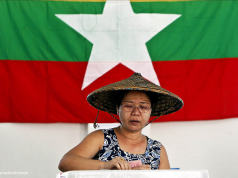General Elections were held on November 8, 2015, the first long awaited nationwide election in 25 years. Voters in all constituencies votedto select representatives in the Upper House (House of Nationalities), the Lower House (House of Representatives) and State and Region Hluttaw (Parliament). After Union Election Commission officially announced the results on November 21, Aung San Su Kyi’s National League for Democracy has obtained the majority of seats; 80 percent of Upper House seats (135 seats out of 168 in total), 70% of Lower House seats (255 seats out of 323), and 75% of State and Regional Parliament seats (475 seats out of 630). Despite her party gaining the landslide victory, Aung San Su Kyi cannot become the president herself under 2008 constitution. However, she said that she will run the government And the Winner is…. and promote national reconciliation and will stand above the president.
The president can name his or her government officials but will have to share power with the military which remains beyond executive authority and will control the keys ministries of defence, interior and border affairs under Myanmar’s Quasi-presidential system. The new Parliament will meet in January and select the president in March. It will be the first time since 1962 that the military establishment does not control the government. In early February, the lower house, upper house and the military have to vote to select one candidate each for the president. These combined houses then form an electoral college to vote one of these three candidates who do not have to be elected members of parliament. The winner will become president and forms a government; while the remaining two will be first vice president and second vice president with largely ceremonial responsibilities. In 2010 election, National League for Democracy (NLD) did not contest and Union Solidarity and Development Party (USDP) has won 259 of 325 seats for House of Representatives and 129 of 168 seats for House of Nationalities. But, in the 2015 general election, 91 political parties including NLD has contested and only 20 parties have won seats in the Parliament.
House of Nationalities (Upper House) In House of Nationalities, 168 of the 224 seats were up for election as 56 seats (25%) are reserved for appointment by the Military.
House of Representatives (Lower House)
In the House of Representative, 330 of the 440 seats were up for election. The remaining 110 seats (25%) were not excluded because of military appointees. 323 seats of the 330 seats were up for election after 7 seats were cancelled due to the ongoing armed insurgencies. And the results are as follows:
State and Regional Hluttaw or Local Assemblies
In the State and Regional Hluttaw (Parliament), 644 district seats (out of a total of 860), of which 630 were up for election after 14 seats were cancelled due to the ongoing armed insurgencies in Shan State. These figures exclude 29 elected Ethnic Affairs Ministers, who have different election parameters. The remaining 216 seats (25%) were not elected as these are reserved for appointments by the military.
State and Regional Assemblies Elections Results (2015)
LEGEND
NLD – National League for Democracy
USDP – Union Solidarity and Development Party ANP – Arakan National Party
SNLD – Shan Nationality League for Democracy ZCD – Zomi Congress for Democracy
MNP – Mon National Party
NUP – National Unity Party
PNO – Pa-O National Organization
TNP – Ta’ang National Party
AMRDP – All Mon Region Democracy Party
SNDP – Shan Nationalities Democratic Party LNDP – Lisu National Development Party
KSDP – Kachin State Democracy Party
KDUP – Kokang Democracy and Unity Party WDP – Wa Democratic Party
NUP – National Unity Party
DP – Democratic Party
KPP – Kayin People’s Party
TLNDP – Tai-Leng Nationalities Development
Party
UDPKS – Unity and Democracy Party of Kachin State
WNUP – Wa National Unity Party
ANDP – Akha National Development Party LHNDP – Lahu National Development Party

